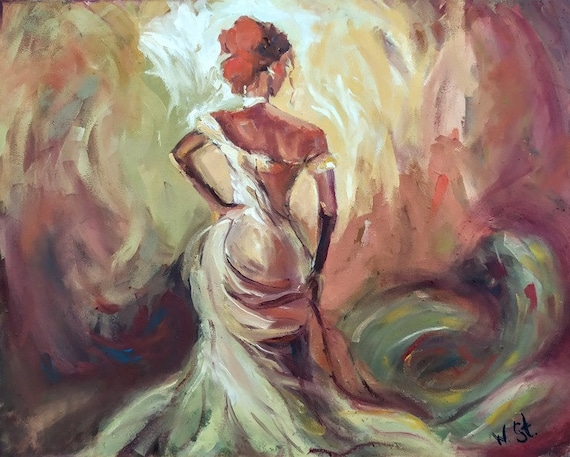A Journey With the World of Figurative Oil Paint: Discovering the Unique Characteristics and Psychological Depth of the Tool

Background of Figurative Oil Painting
Emerging during the late Middle Ages and flourishing throughout the Renaissance, figurative oil paint has an abundant background that mirrors both artistic development and cultural evolution. Oil paints were made use of in Europe as a method to improve the brightness and depth of color in art work. Musicians such as Jan van Eyck originated the medium, showing its possible to catch elaborate details and textures, hence enabling an extra realistic representation of the human form.
As the Renaissance proceeded, prominent numbers like Leonardo da Vinci and Michelangelo broadened the boundaries of metaphorical oil painting. They stressed physiological precision and perspective, developing jobs that conveyed feeling and narrative depth. The medium's convenience permitted experimentation with light and darkness, causing the development of chiaroscuro strategies that additionally enriched the aesthetic experience.
Special Characteristics of the Tool
The development of metaphorical oil painting has been dramatically influenced by the unique characteristics of the tool itself. Oil paint, composed of pigments put on hold in oil, offers musicians an amazing convenience that permits a wide variety of textures and surfaces. Its slow-moving drying time allows thorough blending and layering, which can produce deepness and luminosity unattainable in various other tools.
In addition, oil paint's rich coloring offers lively shades that maintain their intensity gradually. This particular is important in metaphorical painting, where capturing the nuances of complexion and psychological expressions is paramount. The capability to accomplish soft transitions and refined gradients enhances the natural high quality of topics, enabling artists to communicate complex psychological states.
Additionally, oil paint adheres well to various surfaces, such as canvas, wood, and metal, widening the extent of imaginative expression. The tool's adaptability sustains various techniques, from thorough realistic look to meaningful brushwork, making it possible for musicians to discover their specific designs.
Ultimately, the distinct buildings of oil paint not just enhance the visual experience but additionally encourage artists to communicate profound stories, making figurative oil painting a deeply expressive art type.
Designs and strategies Utilized
Within the realm of figurative oil paint, musicians employ a varied variety of methods and styles that add to the deepness and splendor of their work. One popular technique is polishing, where clear layers of paint are used over dried layers, allowing light to mirror and pass through, boosting brightness and depth. This technique is often used to accomplish a feeling of realistic look and intricacy in complexion.
An additional strategy is impasto, where Go Here thick layers of paint are applied with a palette blade or brush, developing a textured surface area that includes a three-dimensional high quality to the paint. This style can evoke a visceral feedback, attracting the customer in via its responsive nature.
Musicians likewise check out various brushwork designs, weblink from penalty, in-depth strokes that capture detailed functions to broader, much more meaningful strokes that communicate activity and emotion (figurative oil painting). The selection of color combination significantly affects the total mood of a piece, with cozy tones frequently imparting feelings of convenience and trendy tones recommending melancholy
Additionally, the combination of chiaroscuro, the comparison between light and shadow, permits artists to create remarkable results that boost the narrative quality of their work. Each method and design is carefully chosen to raise the visitor's experience and understanding.
Psychological Depth in Figurative Art
Emotional deepness works as a keystone in metaphorical art, allowing artists to transcend simple representation and involve customers on an extensive degree. This psychological vibration is frequently accomplished with the nuanced portrayal of human figures, expressions, and interactions. Artists harness the power of shadow, light, and color to evoke feelings that reverberate deeply with the target market, developing a natural link to the subject issue.
In metaphorical oil paint, the complex layering of paint can show the intricacies of human emotion. The option of combination, whether warm or great, plays a crucial role in setting the state of mind and ambience of an item. For example, softer colors might stimulate harmony and self-questioning, while strong, contrasting shades can connect stress and dramatization.

Influential Artists and Their Works
Numerous prominent artists have significantly formed the landscape of metaphorical oil painting, each contributing one-of-a-kind point of views and strategies that continue to inspire contemporary developers. Among these artists, Lucian Freud attracts attention for his intense mental deepness and raw representation of the human form, commonly obscuring the lines between charm and degeneration. Freud's jobs, identified by thick, impasto brushstrokes, invite audiences to face the intricacies of identification and susceptability.

In A Similar Way, Andrew Wyeth's thorough realistic look in items like "Christina's World" captures extensive stories within relatively straightforward make-ups. His usage of light and shadow evokes a feeling of fond memories and emotional resonance, drawing viewers right into the intimate globes he depicts.
In the realm of modern-day art, Kehinde Wiley has actually acquired recognition for his vibrant, epic portraits that challenge typical concepts of representation. By positioning individuals of color in contexts reminiscent of timeless portraiture, Wiley's job redefines the canon of art background.
These artists, along with others, have not just enriched figurative oil paint however have actually likewise expanded the discussion surrounding identification, society, and emotion, making certain that the tool remains an essential type of expression in the art globe. figurative oil painting.
Final Thought
In conclusion, metaphorical oil paint remains an effective medium that envelops the complexities of human emotion via its rich coloring and versatile techniques. The journey via metaphorical oil painting exposes its long-term importance in the why not try this out art world.
The expedition of metaphorical oil paint offers a profound insight right into the interaction of technique, emotion, and historic context that specifies this venerable tool. Oil paint, composed of pigments suspended in oil, offers artists an exceptional convenience that permits for a wide range of finishes and structures.Within the realm of figurative oil painting, musicians use a varied selection of strategies and designs that add to the depth and richness of their job.Countless significant musicians have actually substantially formed the landscape of figurative oil painting, each contributing unique perspectives and techniques that proceed to motivate modern designers.In final thought, figurative oil paint continues to be an effective tool that encapsulates the complexities of human feeling via its abundant coloring and versatile techniques.
Comments on “Unveiling the Secrets Behind Expressive Figurative Oil Painting Styles”